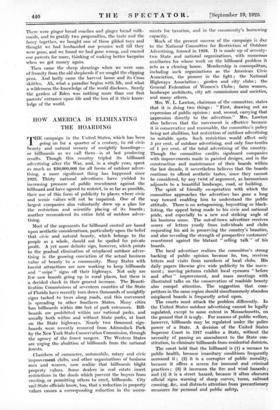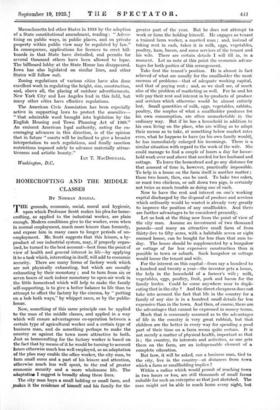HOW AMERICA IS ELIMINATING "THE HOARDING
THE campaign in the United States, -which has been going on for a quarter of a century, to rid civic beauty and natural scenery of unsightly hoardings—. or billboards as we call them—is at last producing results. Though this country tripled its billboard advertising after the War, and, in a single year, spent as much as $50,000,000 for all forms of outdoor adver- tising, a more significant thing has happened since 1928. Thirty national advertisers have yielded to increasing pressure of public resentment against the billboard and have agreed to restrict, in so far as possible, their use of this form of publicity to places where civic and scenic values -will not be impaired. One of the largest companies also voluntarily drew up a plan for the restriction and scientific placing of its boards ; • another reconsidered its entire field of outdoor adver- tising.
Most of the arguments for billboard control are based Upon aesthetic considerations, particularly upon the belief that civic and natural beauty, which belongs to the people as a whole, should not be spoiled for private profit. A yet more definite sign, however, which points to the gradual elimination of misplaced outdoor adver- tising is the growing conviction of the actual business value of beauty to a community. Many States with tourist attractions are now working to keep billboards and " snipe " signs off their highways. Not only are few new boards going up in rural places, but there is a decided check in their general increase. The Beauti- fication Commissions of seventeen counties of the State of Florida have recently torn down thousands of unsightly signs tacked to trees along roads, and this movement is spreading to other Southern States. Many cities ban billboards within- 300 feet of park entrances. Bill- boards are prohibited within our national parks, and usually both within and without State parks, at least on the State highways. Nearly two thousand sign- boards were recently removed from Adirondack Park. by the New York State Conservation Commission, through the agency of -the forest rangers. The Western States are urging the abolition of billboards from the national forests.
Chambers of commerce, automobile, rotary and civic 'improvement clubs; and other 'organizations of business men and women, now realiie that billboards blight property values. Some dealers ' in -real estate insert restrictions in the deeds which prevent the buyers from erecting, or permitting otherS to erect, billboards. City and State officials know, too, that a reduction in property 'values causes a corresponding reduction ' in the assess- meats for taxation, and in the community's borrowing capacity.
Much of the present success of the campaign is dxe to the National Committee for Restriction of Outdoor Advertising, formed in 1923. It is -made up of seventy- two State and national organizations, with numerous auxiliaries for whose work on the billboard problem it acts as a clearing house. Membership is cosmopolitan, including such organizations as the American Civic Association, the pioneer in the fight ; the National Highways Association ; giuden and city clubs ; the General Federation of Women's Clubs ; farm women, landscape architects, city art commissions and societies, and many others.
Mrs. W. L. Lawton, chairman of the committee, states that it is doing two things ; " First, drawing out an expression of public opinion ; and, second, carrying that expression directly to the advertiser." Mrs. Lawton also believes that the movement is effective because it is conservative and reasonable, the committee's policy being not abolition, but restriction of outdoor advertising to suitable spots. Such restriction would affect only 5 per cent. of outdoor advertising, and only four-tenths of 1 per cent. of the total advertising of the country. Though the committee credits signboard companies with improvements made in painted designs, and in the construction and maintenance of their boards within the last decade, it nevertheless believes that the boards continue to offend aesthetic tastes, since they cannot be considered, by any twist of argument, as harmonious adjuncts to a beautiful landscape, road, or building.
The spirit of friendly co-operation with which the committee approaches the advertiser has gone a long way toward enabling him to understand the public attitude. There is no antagonising, boycotting or black- listing, the appeal being made to his civic and national pride, and especially to a new and striking angle of his business sense. The out-of-town advertiser receives scores of letters yearly from individuals and clubs requesting his aid in preserving the country's beauties, and also revealing the strength of prospective customers' resentment against the blatant " selling talk " Of his boards.
The local advertiser realizes the committee's strong backing of public opinion because he, too, receives letters and visits from members of local clubs. His daily papers likewise give wide publicity to the move- ment ; moving pictures exhibit local eyesores " before and after " improvement, and mass meetings with illustrated talks on the conservation of roadside beauty also compel attention. The suggestion that com- petitors in the same region should simultaneously abandon misplaced boards is frequently acted upon.
The courts must attack the problem differently. In the United States outdoor advertising cannot be legally regulated, except to some extent in Massachusetts, on the ground that it is ugly. For reasons of public welfare, however, billboards may be regulated under the pollee power of a State. A decision of the United States Supreme Court in 1917 enables a State, without the necessity of passing an amendment to the State con- stitution, to eliminate billboards from residential districts.
The court held that the billboard is (1) a menace to public health, because insanitary conditions frequently surround it ; (2) it is a corrupter of public morality, because it offers a screen for immoral and criminal practices ; (3) it increases the fire and wind hazards ; and (4) it is a street hazard, because it often obscures official signs warning of sharp curves, turns, railroad crossing, &c., and distracts attention from precautionary measures for personal and public safety. Massachusetts led other States in 1918 by the adoption of a State constitutional amendment, reading : " Adver- tising on public ways, in public places, and on private property within public view may be regulated by law." In consequence,. applications for licences to _erect bill- boards in that State have dwindled, and permits for several thousand others have been allowed to lapse. The billboard lobby at the State. House has disappeared. Iowa has also legislated on similar lines, and other States will follow. suit.
• Zoning regulations of various cities have also done excellent work in regulating the height, size, construction, and, above all, the placing of outdoor advertisements. New York City and Los Angeles lead in this field, but many other cities have effective regulations.
The American Civic Association has been especially active in supporting laws to protect the amenities- " that admirable word brought into legislation by the English Housing and Town Planning Act of 1909." An eminent American legal authority, noting the en- couraging advances in this direction, is of the opinion that in future " courts will be inclined to give a broader interpretation to such regulations, and finally sanction restrictions imposed solely to advance materially attrac- tiveness and artistic beauty."
Washington, D.C.
IAN T. MACDOUGALL.











































 Previous page
Previous page